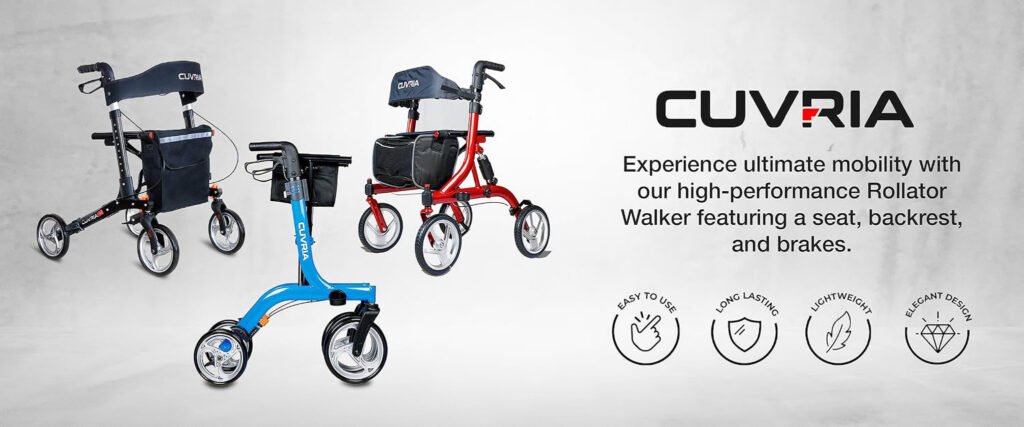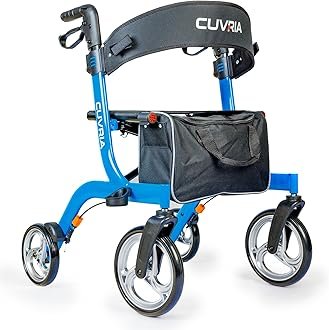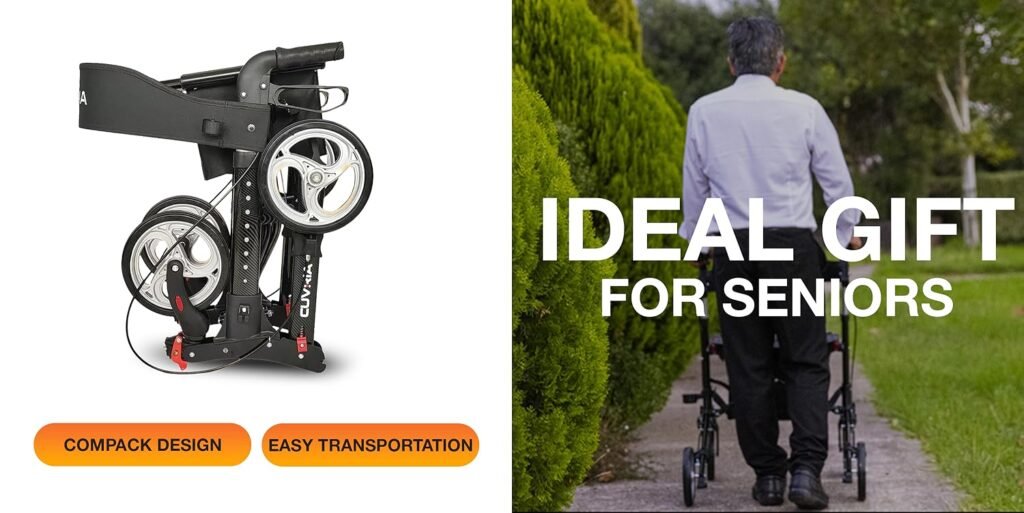how to choose the best rollator | 4 wheel walker
As mobility aids, rollators and 4-wheel walkers provide a combination of stability, comfort, and ease of use for individuals with limited mobility. Selecting the right rollator is essential for enhancing independence and improving quality of life. This guide will walk you through the factors to consider when choosing the best rollator or 4-wheel walker for your needs.
When it comes to choosing a rollator or 4-wheel walker, it’s important to consider your specific mobility needs. Take into account factors such as weight capacity, seat height, and adjustable handlebars to ensure a comfortable fit. Additionally, look for features like locking brakes and a storage pouch for added convenience. Remember to compare different models and read customer reviews to make an informed decision. With the right rollator, you can regain independence and enjoy greater mobility in your daily life.
1. Understand the purpose of a rollator
Rollators are designed to provide balance and support while walking. They’re ideal for individuals who can walk but require assistance to reduce the risk of falls, manage fatigue, or increase mobility. Unlike traditional walkers, rollators have wheels for smoother movement and often include additional features like seats and storage compartments.
who can benifit from a rollator?
- Seniors experiencing mild to moderate mobility challenges
- Individuals recovering from surgery or injury
- People with chronic conditions such as arthritis, Parkinson’s disease, or COPD
Understanding your specific mobility needs is the first step in finding the right rollator.
2. types of rollator
Rollators come in various designs, each catering to different needs and preferences. Here are the most common types:
Standard Rollators
- Features: Four wheels, a padded seat, and a storage compartment
- Best For: Everyday use indoors and outdoors
Lightweight Rollators
- Features: Minimalist design with an emphasis on portability
- Best For: Travel and individuals who require frequent folding and storage
Bariatric Rollators
- Features: Heavier frames, wider seats, and higher weight capacities
- Best For: Larger individuals needing robust support
Specialty Rollators
- Features: Unique designs for specific conditions (e.g., rollators for narrow spaces or off-road use)
- Best For: Users with specialized mobility needs
3. key features to consider
When selecting a rollator, focus on features that align with your lifestyle and mobility requirements.
a) Wheels
- Size: Larger wheels (8-12 inches) provide better maneuverability on uneven surfaces, while smaller wheels are ideal for indoor use.
- Material: Durable rubber or polyurethane wheels ensure a smooth ride.
b) Braking System
- Hand Brakes: Easy-to-use brakes increase safety and control.
- Locking Mechanism: Essential for stability when sitting on the rollator’s seat.
c) Seat and Backrest
- Seat Width: Ensure the seat is wide enough for comfort.
- Padding: A padded seat and backrest offer added comfort during rest breaks.
d) Weight and Portability
- Lightweight rollators are easier to transport and fold.
- Consider the folded dimensions to ensure it fits in your vehicle or storage space.
e) Height Adjustability
- Adjustable handles accommodate users of different heights, promoting proper posture and reducing strain.
f) Weight Capacity
- Standard rollators typically support up to 300 pounds, while bariatric models can handle 400 pounds or more.
g) Storage Options
- Look for rollators with baskets, pouches, or trays to carry personal items conveniently.

4. assessing your needs
a) Environment
- Indoors: Opt for smaller wheels and compact designs for maneuverability in tight spaces.
- Outdoors: Larger wheels and sturdy frames handle uneven terrain better.
b) Frequency of Use
- Daily use rollators should prioritize comfort and durability.
- For occasional use, consider lightweight and portable models.
c) Physical Condition
- Evaluate your strength and dexterity to ensure you can operate the rollator’s brakes and folding mechanism easily.
- Discuss your needs with a healthcare provider if you have specific medical conditions.

5. top brands and models
Drive Medical
- Known for durable and affordable rollators
- Popular models: Nitro Euro-Style Rollator, Clever-Lite Rollator
Nova Medical Products
- Offers stylish designs with innovative features
- Popular models: Zoom Rollator, GetGo Petite Rollator
Cuvria Rollator
- Renowned for compact, lightweight designs with ample storage
- Popular model: Carbon Fiber Print – compact with quick release knobs
- Stylist design and affordable rollator
Medline
- Affordable options with solid performance
- Popular models: Medline Ultralight Freedom Rollator, Heavy-Duty Rollator
6. trying before buying
Whenever possible, test the rollator before purchase to ensure it meets your expectations:
a) Comfort
- Sit on the seat and check for adequate support.
- Walk with the rollator to evaluate handle height and ergonomics.
b) Maneuverability
- Test the rollator on various surfaces, including carpets, hardwood floors, and sidewalks.
- Assess how easily it turns and brakes.
c) Portability
- Practice folding and unfolding the rollator.
- Check if it fits in your car or designated storage area.
7. budget considerations
Rollators range in price from $50 to $500, depending on features and build quality. Here are some tips for budgeting:
Basic Models: $50-$150 (suitable for occasional use)
Mid-Range Models: $150-$300 (ideal for daily use with added features)
High-End Models: $300-$500 (premium designs with advanced functionality)
Cost-Saving Tips
Look for sales or discounts online.
Check if your insurance covers mobility aids.
Consider refurbished models for affordability.
8. maintaining your rollator
Proper maintenance ensures your rollator remains functional and safe:
a) Regular Inspections
Check brakes, wheels, and frame for wear and tear.
Tighten loose screws or bolts.
b) Cleaning
Wipe down the frame and seat regularly.
Clean wheels to remove debris.
c) Storage
Store in a dry area to prevent rust and damage.
Avoid overloading storage compartments.
9. when to replace your rolaltor
Replace your rollator if:
The frame is bent or damaged.
Brakes no longer function properly.
It no longer meets your mobility needs.
10. shopping online for rollators
Many rollators are now sold online, offering convenience and a wide selection. While this can feel intimidating, many retailers provide detailed product descriptions, customer reviews, and free return policies, ensuring you can shop with confidence. Take advantage of these policies to test the rollator in your environment and return it if it doesn’t meet your needs.
conclusion
Choosing the best rollator or 4-wheel walker involves balancing your mobility needs, lifestyle, and budget. By understanding the available options and evaluating key features, you can find a rollator that enhances your independence and comfort. Don’t hesitate to consult healthcare professionals for personalized recommendations, and remember to prioritize safety and quality in your decision. A well-chosen rollator can transform your mobility experience, enabling you to stay active and confident in your daily life. If you like the article please help share so other also can get the inform decision. You also can check out our store.







